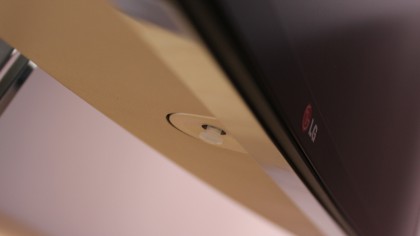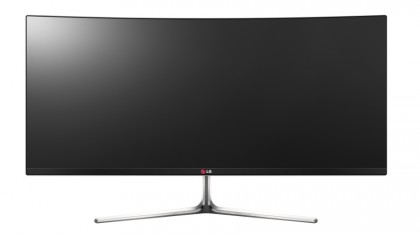Why you can trust TechRadar
Interface
LG doesn't have any buttons on the front of this screen – instead, its menu is controlled with a small joystick that sits in the middle of the underside. It's an unusual bit of kit: tapping the stick opens the menu, and moving it in four directions navigates the various options.
It's initially confusing, but soon becomes second-nature, and it's helped by the menu itself – the interface is large, taking up the entire right-hand side of the screen, and is sensibly laid out. The Samsung SD590CS has a sharper menu with more options, but the LG isn't far behind.

Performance
We tested the LG with an X-Rite i1 Display Pro colorimeter, and the 34UC97 got off to a good start at factory settings. The measured brightness level of 232cd/m2 is ample, and it's bolstered by a black level of 0.21cd/m2 – another good result. Those figures combine for a contrast ratio of 1,104:1, which is good enough to ensure deep blacks, bright whites, and a wide gamut of different shades in between. Viewing angles are great, too – there's no distortion even when gazing at far-flung corners of the screen, or looking from odd angles.
Colours are reasonably accurate as well. We measured the factory Delta E at 2.67, which is decent – anything below 2 is stonking, but that's usually the preserve of more expensive professional panels.
LG augments its screen with several modes designed for different scenarios. They're a mixed bag: we'd use the Cinema and Photo modes for day-to-day work, as they both improve the colour accuracy and temperature without compromising contrast. The Reader mode tones down the brightness and colour accuracy, though, and Gaming mode isn't much better. The warm, medium and cool colour temperature options aren't much cop, either – they warp the screen to such a degree that we can't see them being useful in many scenarios.
We got our best results by manually calibrating the panel with our Colorimeter. The Delta E improved to 1.02, and the colour temperature sat at a revised 6,569K – close to the 6,500K ideal figure. We achieved this level of performance by taking the screen's default green setting down five notches and raising the brightness by three notches.

The LG delivered accurate colours and good contrast across most of our tests, but the 34UC97 couldn't maintain good uniformity – an issue that's particularly prominent on widescreen panels. The LG's top edge lost an average of 9.6% of its brightness when compared to the middle of the screen, and the bottom edge lost 10.8%. That's not a great result, and you may notice a lack of depth in the corners during darker scenes in movies or games.
Sign up to the TechRadar Pro newsletter to get all the top news, opinion, features and guidance your business needs to succeed!
We used a Leo Bodnar testing device to measure the LG's input lag. It's not a gaming screen, but the 34UC97's input lag sat at 16.6ms. That's excellent, and will only be beaten by dedicated gaming panels. It means the LG is good enough for gaming – only pro players will have the reflexes to notice any input lag.
Our final tests evaluated the LG's audio kit. Its speakers have enough volume to fill an office or bedroom, and there's a surprising amount of bass. The dominant deep notes overshadow the mid-range, though, and affect the top-end just as badly.
LG includes its MaxxAudio software to improve treble response, and it does make things better – but we'd still rather use external speakers.
Mike has worked as a technology journalist for more than a decade and has written for most of the UK’s big technology titles alongside numerous global outlets. He loves PCs, laptops and any new hardware, and covers everything from the latest business trends to high-end gaming gear.
